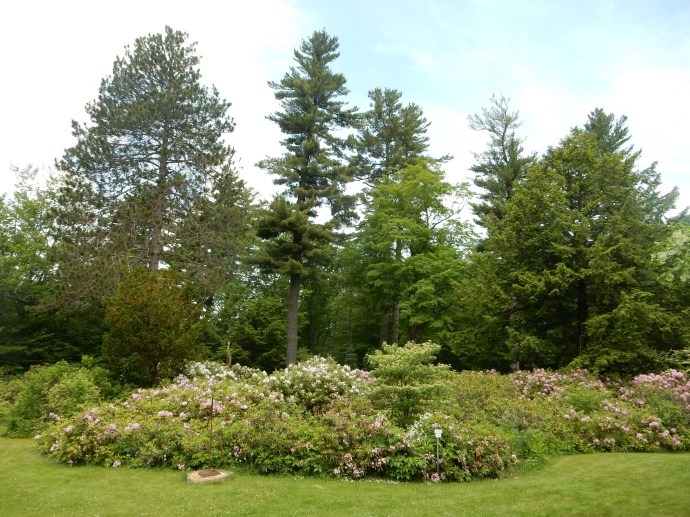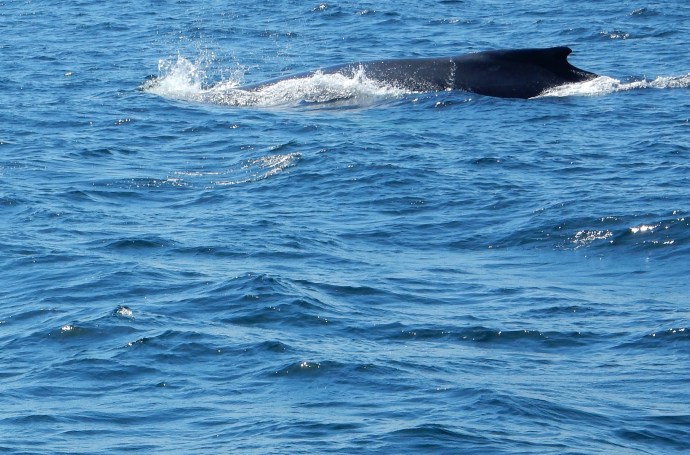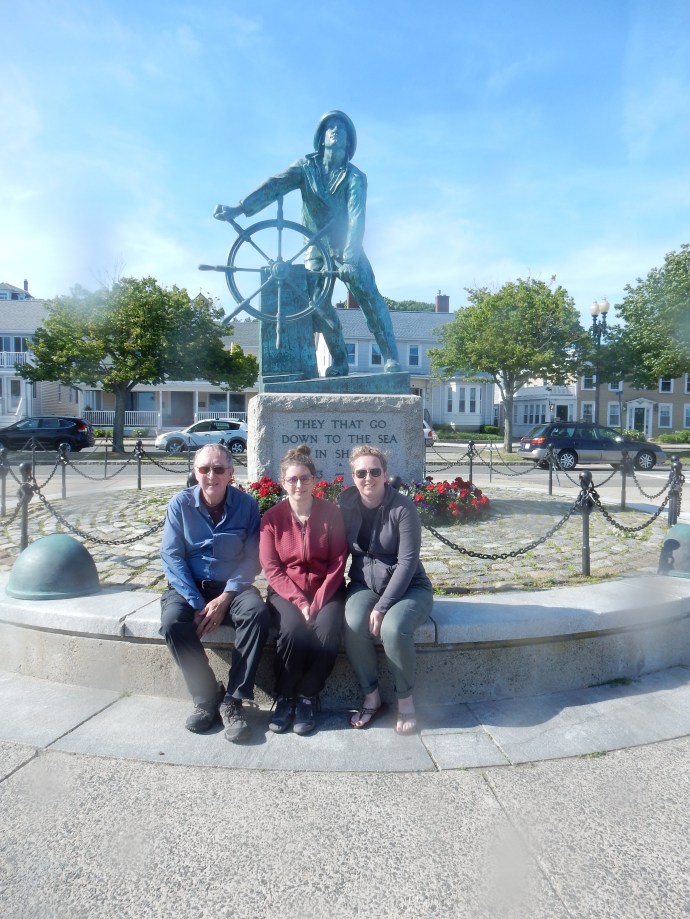 The Robert Shaw Memorial-original in Boston Commons-from the Saint-Gaudens National Historic Site in Cornish NH
The Robert Shaw Memorial-original in Boston Commons-from the Saint-Gaudens National Historic Site in Cornish NH
Grantham, NH. June 18
Decades ago when I first drove through Connecticut I was surprised by the hills and greenery. I just had this vision of the state as all urban concrete. I thought of that long ago memory Monday as we drove from Gloucester MA to Cornish NH. My sense of the geography of this region has certainly become more accurate but my pleasure at viewing the hills and greenery has not diminished. The rocky coast along Gloucester gave way (after the Boston urbanization area) to the hills, mountains and forests of New Hampshire. Along I-93 as we crossed into NH, there were several stretches where wildflowers must have been planted in the median. Combinations of white intermixed with yellow flowers were followed by a blueish-purple tinged flower. The woman at the NH information center was not aware of them, not driving that way to get to her job. They were profuse enough that they reminded us of our drives among the bluebonnets of Texas highways.
 Driving along New Hampshire highways
Driving along New Hampshire highways
Trying to be accurate, I did some Internet research to discover the types of flowers. Well, I found out that they are lupine, oxeye daisies, black eyed Susans, and coreopsis. The state has planted them for erosion control and visual impact. Evidently the seeding occurred before this spring because the same article indicated that due to budget cuts, state roads were having streetlights turned off, grass not cut, pavement marking lines not painted, and less guardrail maintenance. Ironically, at another stop, the cashier proudly stated that NH has no state income tax or general sales tax.
We are in New Hampshire and Vermont to visit two National Park sites. Monday we visited Saint-Gaudens National Historic Site in Cornish NH, along the Connecticut River which forms the Vermont border. (And we passed a section of road where one of the two lanes had washed out.) Augustus Saint-Gaudens (1848-1907) was a great American sculptor who came to Cornish for summers beginning in 1885 and to live year-round from 1900 until his death. This is only one of two National Park Service sites dedicated to the visual arts. The property was donated to the National Park Service in 1965.
The property includes his home, studios and galleries and is situated on 195 acres of woods, gardens and farm land.Our plan was to catch the 15 minute presentation at noon about sculpting but the in-residence sculptor had the day off. We walked along the ravine trail listening to the gurgling brook and enjoying the cool forest air. The park offers an 18 minute introductory video about Saint-Gaudens, his life, and works. (The video did not mention his mistress or the son he had with her.)
 Two of Saint-Gaudens major works
Two of Saint-Gaudens major works
Saint-Gaudens came as an infant to America from Ireland and was apprenticed early to a cameo maker. He attended classes in New York, Paris, and Rome where he met his wife. Returning to New York, he received his first major commission, a statue of Civil War Admiral David Farragut. When completed in 1881, it received overwhelming adulation. Over his career, he created several monumental sculptures still well-known today: The Shaw Memorial on Boston Commons, the Sherman Monument in New York’s Central Park, the “Standing Lincoln” in Chicago’s Lincoln Park. The Shaw Memorial took 14 years to complete and features Col Shaw leading the Massachusetts 54th Regiment, the first all African American regiment from a Northern state. The individual features of the numerous soldiers is striking.
Saint-Gaudens created numerous smaller sculptures, miniatures, and cameos over his career. President Teddy Roosevelt made him the first sculptor to fully design an American coin; the one cent coin, and the 10- and 20-dollar double eagle gold coin. He died in 1907 from cancer.
 Aspet House, Saint-Gaudens home in Cornish NH
Aspet House, Saint-Gaudens home in Cornish NH
Aspet House, his home in Cornish, was open for visitation and we explored it thoroughly. We took a tour of the grounds with a ranger whose presentation focused on Saint-Gaudens influence on the Gilded Age, that period from after the Civil War to about 1900. The Gilded Age was marked by rapid industrialization, wage growth for all but still with great concentrations of wealth and marked poverty. The people who commissioned Saint-Gaudens were among the very elite and had no problem with demonstrating their wealth.
Dinner (and lunch) was a quick bite at Wendy’s and a large ice cream at Fore-U Ice cream, a local store in West Lebanon. Our lodging is a wonderful AirBnB in Grantham, NH; out in the country surrounded by woods and gardens. The unit is a two bedroom stocked with multiple options for breakfast.
Tuesday we drove 40 miles to Woodstock Vermont, home to the Marsh-Billings-Rockefeller National Historical Park. The site has three names to reflect the three families that lived here and who each played a role in the national conservation movement and the evolving nature of land stewardship in America.
George Perkins Marsh (1801-1882) grew up here on the farm, was a U.S. Congressman, and a long-serving American ambassador. From the vantage point of overseas postings, he realized the impact humans made on the land. The timber industry in Vermont denuded mountainsides of trees, with no tree re-plantings and increased erosion. He advocated for a new, more caring focus on land stewardship. In 1864, he wrote Man and Nature, a book still in publication and which became a bedrock for future conservation efforts.
Frederick Billings ((1823-1890) grew up in Vermont, about 20 miles north of Woodstock. Trained as a lawyer, he made his fortune resolving land sales and issues in California during the Gold Rush era. He returned to Vermont, purchasing the Marsh family farm in 1869. By the time of his return, the Vermont mountains were stripped of trees, erosion had filled rivers, and farm fields were unproductive. Billings created a model farm to help educate farmers and revitalize Vermont agriculture. Sustainable, scientific forestry was a major focus of his life.
 Inside the Marsh-Billings-Rockefeller mansion
Inside the Marsh-Billings-Rockefeller mansion
After Billings death, his wife and daughters continued the commitment to sustainable forestry. Eventually the property passed to his granddaughter Mary French who married Laurance Rockefeller, grandson of John D. Rockefeller. The Rockefellers had played a major role in U.S. National Parks and Laurance continued that tradition in many ways. Here, he and his wife transferred the land and an endowment to the National Park Service and this became a National Historical Park in June 1998.
 walking the grounds at Marsh-Billings-Rockefeller
walking the grounds at Marsh-Billings-Rockefeller
Besides the park video, we participated in two ranger talks and hikes. During the tour of the mansion, besides viewing the interior, the ranger explained in greater detail how the three families played an important role in creating and sustaining a view of improved stewardship of our natural resources. On our ecology hike through the forest, we discussed with the park ranger the damage still being done to forests by man, creature, and climate.
Two Minnesota notes. One of the volunteers, while living in Vermont now, had a connection to Minnesota as his grandfather lived in North St. Paul, one of the towns of my youth. His grandfather started the Ramsey County Review, the local newspaper. Frederick Billings had a strong role in the development of the Northern Pacific Railway, which fueled the development of the U.S. from the Dakotas to the Pacific Ocean. The Northern Pacific was constantly plagued by financial issues and eventually was absorbed by the Great Northern. Billings time with the Northern Pacific was well-regarded, and the town of Billings Montana is named after him.
Ed and Chris. Grantham NH. June 18
 Teddy Roosevelt slept here at The Fells and planted a tree on the property which is still growing.
Teddy Roosevelt slept here at The Fells and planted a tree on the property which is still growing. The Fells building
The Fells building

 The Robert Shaw Memorial-original in Boston Commons-from the Saint-Gaudens National Historic Site in Cornish NH
The Robert Shaw Memorial-original in Boston Commons-from the Saint-Gaudens National Historic Site in Cornish NH Driving along New Hampshire highways
Driving along New Hampshire highways Two of Saint-Gaudens major works
Two of Saint-Gaudens major works Aspet House, Saint-Gaudens home in Cornish NH
Aspet House, Saint-Gaudens home in Cornish NH Inside the Marsh-Billings-Rockefeller mansion
Inside the Marsh-Billings-Rockefeller mansion walking the grounds at Marsh-Billings-Rockefeller
walking the grounds at Marsh-Billings-Rockefeller
 View from our room towards Good Harbor beach.
View from our room towards Good Harbor beach. Saturday morning at Good Harbor Beach
Saturday morning at Good Harbor Beach Our whale
Our whale Man at the Wheel statue
Man at the Wheel statue Our Lady of Good Voyage church in Gloucester
Our Lady of Good Voyage church in Gloucester Ed enjoying the art in Rockport
Ed enjoying the art in Rockport
Recent Comments